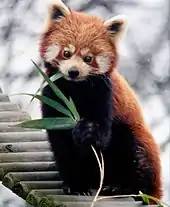Red panda
The red panda (Ailurus fulgens) is a mammal. It is the only species of the Ailuridae family. There are two subspecies: Ailurus fulgens fulgens and Ailurus fulgens styani. It is also known as lesser panda, cat-bear, bear-cat and firefox.
| Red panda | |
|---|---|
 | |
| Scientific classification | |
| Kingdom: | |
| Class: | |
| Order: | |
| Suborder: | |
| Superfamily: | Musteloidea |
| Family: | Ailuridae |
| Genus: | Ailurus |
| Binomial name | |
| Ailurus fulgens | |
Overview
Most that are bred at Japanese zoos are Ailurus fulgens styani. They are called レッサーパンダ in Japan and 小熊貓 (xiǎo xìong māo ) in China, both literally translating to English as "small bear-cat", or "fox-bear". They have become popular for how they look.[1] The IUCN classes them as 'vulnerable'
The red panda is not closely related to the giant panda: they are in different families, but share a vegetarian diet. They have both adapted to eating plant material, which is unusual for members of the Carnivora.
A scientist by the name Brian Houghton Hodgson was one of the first people to look more deeply into the Red Panda because up until he did, there was not much known about the species. In addition to Bamboo, the Red Panda also eats fruits, tuberous roots, acorns, and beechmast. The Red Panda is not necessarily nocturnal but is classified as crepuscular which means they are active around dawn and sleep during the night and midday. Besides how they slept, Hodgson observed that they were monogamous and only breed once a year.
Habitat
The red panda lives in the southern part of China, Sikkim, Nepal, and the Himalaya mountains in high trees. In the Indian kingdom of Sikkim it is the state animal. As an endangered species it is protected by laws in the countries where it lives. 2 nearly complete skeletons have been found at the Gray Fossil Site in Gray, Tennessee.
Appearance and life
Red pandas are about 50-60 centimeters long. They weigh between three and five kilograms. They have chestnut colored hair, and their faces have white designs. They eat fruits, roots, bamboo shoots, acorns, and insects. They are active at night and sleep on trees in the daytime. They act alone, not in groups. They eat blossoms, berries, various plants, and bird eggs.
References
Glatston, A. R. (2011). Red panda biology and conservation of the first panda (1st ed.). Academic Press.
